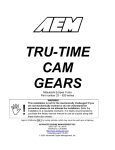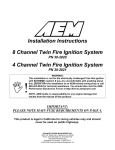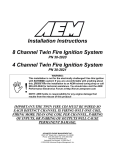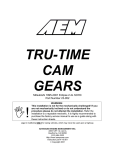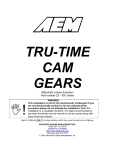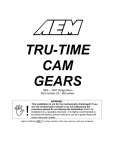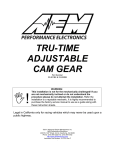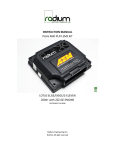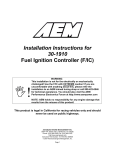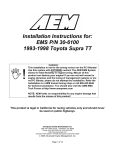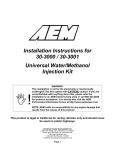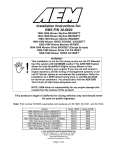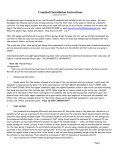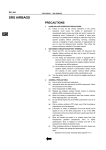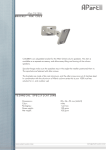Download Manual
Transcript
TRU-TIME CAM GEARS 1993 – 2000 Dodge Neon SOHC Part number 23 – 851 ,! WARNING: This installation is not for the mechanically challenged! If you are not mechanically inclined or do not understand the procedure please do not attempt the installation. Refer the installation to a reputable mechanic. It is highly recommended to purchase the factory service manual to use as a guide along with these instruction sheets. Legal in California ONLY for racing vehicles, which may never be used upon a highway. ADVANCED ENGINE MANAGEMENT INC. 15606 South Broadway Center Street, Gardena, CA. 90248 Phone: (310) 258-0030 Fax: (310) 258-0036 Http://www.a-e-m.com E-Mail: [email protected] You have just purchased the BEST adjustable cam sprockets available. These AEM adjustable cam sprockets are CNC machined from billet aluminum and then laser etched with cam timing marks for adjustment up to ±10° at the cam or ±20° at the crankshaft. Using the vernier scale on the sprocket hub helps to perform cam timing changes quickly and accurately. The inner hub is anodized for lasting beauty and resistance to corrosion. The out gear sector is hard anodized for resistance to wear. We have found that there are significant power gains to be made by adjusting the cam timing even with stock cams and compression. Adjustable cam sprockets are usually required in applications where an aftermarket or reground performance cams are installed or the cylinder head has been milled 0.005” or more. The use of these cam sprockets allows the extraction of maximum power from your engine. We have recorded gains of up to 10~15 horsepower due to cam timing tuning using adjustable cam sprockets. When aftermarket or reground cams are installed, the original manufacturer’s cam timing specifications are no longer accurate. These adjustable cam sprockets allow you to make necessary adjustments to cam timing to maximize the performance of your engine. This is accomplished by “degreeing in” the optimum cam timing for a particular engine set up. The adjustable cam sprocket is especially effective when used with heads that have been milled. The adjustability of the sprocket allows the accommodation of the changes in cam timing due to the variation of timing belt length from the bottom sprocket to the top sprocket when the head is milled. If the head has been milled 0.005” or greater the relationship between the head and the block is altered by moving the head closer to the crankshaft resulting in retarded cam timing. It must be emphasized that the preceding descriptions are generalizations and any adjustments made must be done with a conservative approach and on a dynamometer or on a racetrack. We do not condone any illegal activity on the street. Read and understand these instructions BEFORE attempting to install this product Front Cover Removal a) It is important that the installer familiarize themselves with the procedures before starting the installation. This procedure requires some Chrysler specific tools, which cannot be substituted with other ordinary tools. If you do not have access to these Chrysler tools please refer the installation process to a qualified mechanic that does. It is important to have a factory service manual available for reference while undertaking this installation. This procedure is best accomplished using a lift. If a suitable lift is not available, for safety reasons, use appropriately rated jackstands. b) Disconnect the negative battery cable. c) Remove all the accessory drive belts. i) Alternator drive belt ii) Air conditioning and power steering pump belt. d) Remove the right front wheel. i) Remove the right inner splash shield and the right engine-mount bolt access plug. e) Remove crankshaft damper bolt. Remove damper using Special Tool 1026 and insert 6827-A or equivalent pulling tool. (Fig. 1) f) Remove Right Engine Mount (Fig. 2) i) Position a floor jack carefully under the transmission and engine and use to take the load off the right engine mount. ii) Remove purge duty solenoid from the engine mount bracket. iii) Remove the vertical fasteners and the thru-bolt. iv) Remove the engine mount. g) Remove the power steering pump and set aside. This will allow you to move the power steering hoses from the front of the engine. Do not disconnect any power steering hoses. If you do disconnect any hoses then the o-rings at the banjo connections at the top of the pump will need to be replaced. h) Remove the engine mount bracket. (Fig. 3) i) Remove the front timing belt cover. j) Loosen but do not remove the cam gear retaining bolt. k) Align the camshaft and the crankshaft timing marks by rotating the engine with the crankshaft before loosening or removing the timing belt. Note: There are two different methods used for timing belt tensioning, mechanical and hydraulic. Please refer to the appropriate section based upon your model. 2) Timing Belt Removal a) Hydraulic Tensioning i) Loosen the timing belt tensioner fasteners and remove timing belt and tensioner. Do NOT loosen, tighten, or remove the tensioner pivot bolt. (Fig. 4) b) Mechanical Tensioning i) Insert a 8mm Allen wrench into the belt tensioner. Before rotating the tensioner insert the long end of a 1/8” or 3mm Allen wrench into the pin hole on the front of the tensioner. Rotate the tensioner counterclockwise with the Allen wrench, while pushing in lightly on the 1/8” or 3mm Allen wrench, until it slides into the locking hole. (Fig. 5) ii) Remove timing belt. Note: Do not rotate the camshaft once the timing belt has been removed or damage to the valve components may occur. 3) Cam Gear Removal a) Remove the cam gear retaining bolt, and slide the stock cam gear off the camshaft. b) Install the AEM Adjustable Cam Gear in the reverse process of removing the stock cam gear. c) Finger tighten the cam gear retaining bolt. Do not torque the cam gear retaining bolt until the timing belt is installed. If you tighten the cam gear retaining bolt before the timing belt is installed then damage to the valve components may occur. 4) Timing Belt Installation (refer to step a or step b depending on the model of your vehicle.) a) Hydraulic Tensioner i) Place the hydraulic tensioner into a vise that is equipped with soft jaws. Slowly compress the plunger until the hole in the plunger lines up with the hole in the tensioner body. Insert the metal rod that is supplied in the kit through the tensioner body and plunger to retain the plunger in place until tensioner is installed. (Fig. 6) ii) Set the crankshaft sprocket to TDC by aligning the sprocket with the arrow on the oil pump housing, then back off 3 notches before TDC. (Fig. 7) iii) Set the camshaft to TDC by aligning the mark on the cam gear with the mark on the rear timing belt cover. iv) Move crankshaft to ½ mark before TDC for belt installation. (Fig. 8) v) Install timing belt. Starting at the crankshaft, go around the water pump sprocket and then around the cam gear. vi) Move the crankshaft sprocket to TDC to take up belt slack. Install tensioner to engine block but do not tighten fasteners. vii) Use a torque wrench to apply 250 in.-lbs. of torque to the tensioner pulley. viii)With torque being applied to the tensioner pulley move the tensioner up against the tensioner pulley bracket and tighten fasteners to 275 in.-lbs. ix) Pull tensioner plunger pin. Pretension is correct when pin can be removed and installed. x) Rotate crankshaft through two revolutions and check the alignment of the timing marks. b) Mechanical Tensioner i) Set the crankshaft sprocket to TDC by aligning the sprocket with the arrow on the oil pump housing, then back off 3 notches before TDC. (Fig. 7) ii) Set the camshaft to TDC by aligning the mark on the cam gear with the mark on the rear timing belt cover. iii) Move crankshaft to ½ mark before TDC for belt installation. (Fig. 8) iv) Install timing belt. Starting at the crankshaft, go around the water pump sprocket and then around the cam gear. v) Move the crankshaft sprocket to TDC to take up belt slack. vi) Remove the 1/8” or 3mm Allen wrench from belt tensioner. vii) Rotate crankshaft through two revolutions and check the alignment of the timing marks. 5) Reassembly a) b) c) d) e) f) g) Torque the cam gear retaining bolt to 85 ft.-lbs. Reinstall the timing belt cover. Install engine mount bracket. Torque bolts to 30 ft.-lbs. Install power steering pump assembly. Install right engine mount. Remove jack from under engine. Reinstall crankshaft damper using M12x1.75x150mm bolt, washer, thrust bearing and nut from Special Tool 6792. Install crankshaft damper bolt and torque to 105 ft.-lbs. h) Install accessory drive belts. Replace if they show any signs of deterioration. i) Reinstall the right inner splash shield. j) Perform relearn camshaft and crankshaft alignment procedure in the Engine Miscellaneous Section of the DRB Scan Tool. Reference Diagrams: Fig 1: Crankshaft Damper Removal Fig 2: Right Engine Mount Removal Fig 3: Engine Mount Removal Fig 4: Hydraulic Tensioner Fig 5: Mechanical Tensioner Fig 6: Compressing Hydraulic Tensioner Fig. 7: Aligning Crank to 3 Notches from TDC Fig. 8: Aligning Crank to the ½ Mark For Technical Inquiries Please E-mail us at [email protected]







